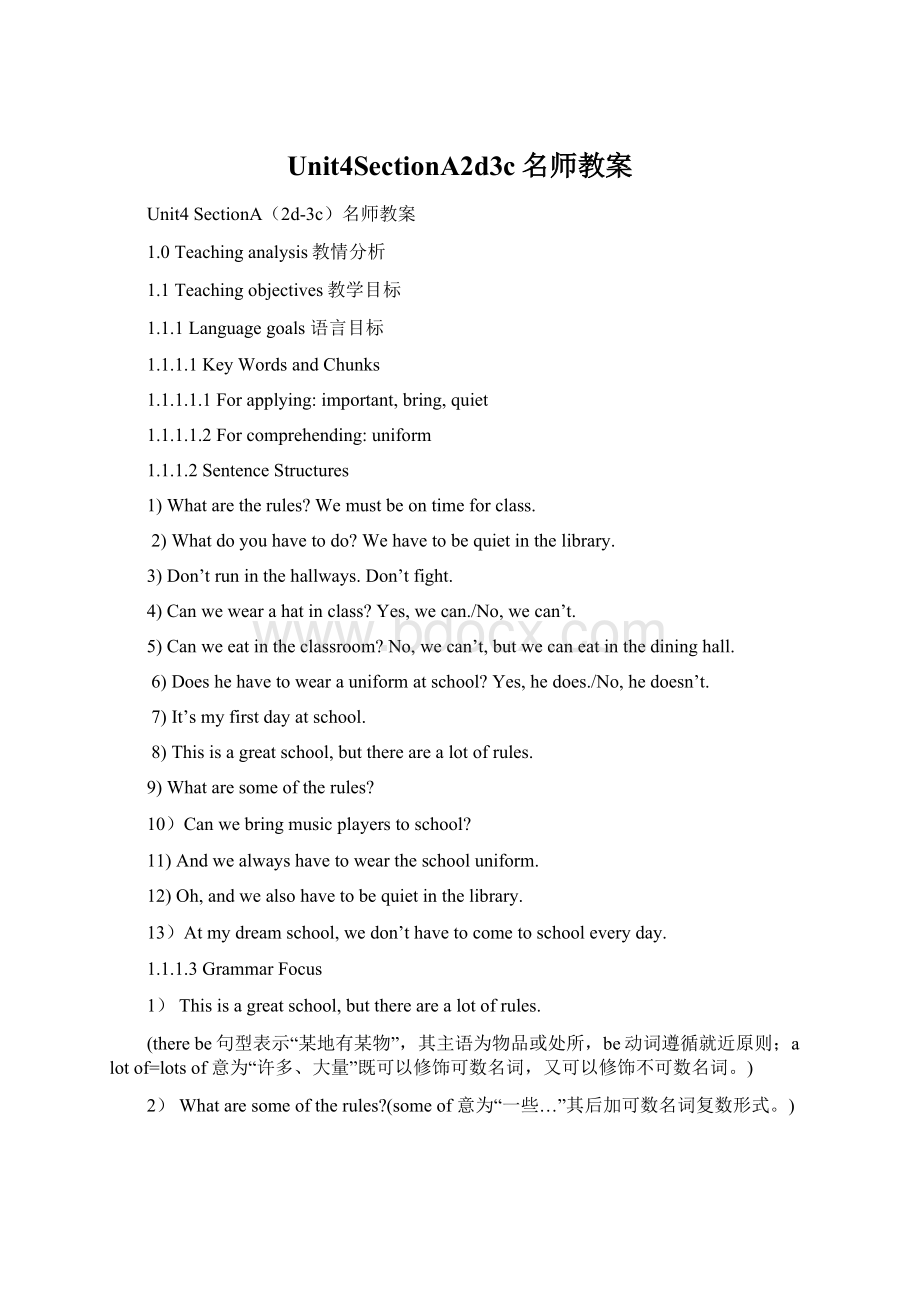Unit4SectionA2d3c名师教案.docx
《Unit4SectionA2d3c名师教案.docx》由会员分享,可在线阅读,更多相关《Unit4SectionA2d3c名师教案.docx(9页珍藏版)》请在冰豆网上搜索。

Unit4SectionA2d3c名师教案
Unit4SectionA(2d-3c)名师教案
1.0Teachinganalysis教情分析
1.1Teachingobjectives教学目标
1.1.1Languagegoals语言目标
1.1.1.1KeyWordsandChunks
1.1.1.1.1Forapplying:
important,bring,quiet
1.1.1.1.2Forcomprehending:
uniform
1.1.1.2SentenceStructures
1)Whataretherules?
Wemustbeontimeforclass.
2)Whatdoyouhavetodo?
Wehavetobequietinthelibrary.
3)Don’truninthehallways.Don’tfight.
4)Canwewearahatinclass?
Yes,wecan./No,wecan’t.
5)Canweeatintheclassroom?
No,wecan’t,butwecaneatinthedininghall.
6)Doeshehavetowearauniformatschool?
Yes,hedoes./No,hedoesn’t.
7)It’smyfirstdayatschool.
8)Thisisagreatschool,buttherearealotofrules.
9)Whataresomeoftherules?
10)Canwebringmusicplayerstoschool?
11)Andwealwayshavetoweartheschooluniform.
12)Oh,andwealsohavetobequietinthelibrary.
13)Atmydreamschool,wedon’thavetocometoschooleveryday.
1.1.1.3GrammarFocus
1)Thisisagreatschool,buttherearealotofrules.
(therebe句型表示“某地有某物”,其主语为物品或处所,be动词遵循就近原则;alotof=lotsof意为“许多、大量”既可以修饰可数名词,又可以修饰不可数名词。
)
2)Whataresomeoftherules?
(someof意为“一些…”其后加可数名词复数形式。
)
3)Canwebringmusicplayerstoschool?
(本句是一个can引导的一般疑问句,bring…to…意为“把…带来…”,表示离说话人距离越来越近,其对应词组take…to…意为“把…带到...”,表示离说话距离越来越远。
)
4)Andwealwayshavetoweartheschooluniform.(情态动词haveto意为“不得不,必须”第一、二人称和第三人称复数用haveto,主语是第三人称单数用hasto,其后跟动词原形,注意区分haveto表示客观“不得不、必须”,must表示主观意愿的“必须”。
)
5)Oh,andwealsohavetobequietinthelibrary.(also意为“也”用在实前be后,too“也”用在句末,bequiet意为“保持安静”=keepquiet。
)
6)Doeshehavetowearauniformatschool?
(haveto为情态动词后接动词原形,一般现在时主语为三人称单数应用hasto,本句为一般疑问句由于有助动词Does,所以hasto还原为haveto)
7)Whatdoyouhavetodo?
(本句为特殊疑问句,What…do对动词或动词短语提问。
)
8)Don’ttalk.(本句为祈使句的否定形式,Don’tdo=Nodoing。
)
9)Atmydreamschool,wedon’thavetocometoschooleveryday.(cometo意为“来到”其后接名词,其对应词为goto意为“去到”;everyday为副词意为“每天”修饰动词,everyday为形容词意为“每天的”修饰名词。
)
1.1.2Abilitygoals能力目标
1.1.2.1教会学生能够熟练地运用祈使句、情态动词can、must及haveto表达规章制度。
1.1.2.2培养学生学会观察并归纳总结出相应的语法知识项目。
1.1.2.3教会学生学会正确运用目标语言谈论和制定学校或家庭规则。
1.1.3Emotionalgoals情感目标
通过本课时学习引导学生遵守校园规则,并能用目标语言表达和制定学校及家庭的规则。
1.2Importantanddifficultteachingpoints教学重难点
1.2.1 情态动词must和haveto表示“必须”用法的异同。
1.2.2情态动词can表示许可用法及其肯定否定式表达规章制度的用法。
1.2.3熟练运用目标语言表达和制定相关规定。
2.0Studentanalysis学情分析
2.1FundamentalState基本情况
本课时为本单元的第二课时,是对本单元话题的目标语言地巩固和加强,本课以2d对话为导入,进一步复习和巩固祈使句的用法,以及情态动词can和must的用法,让学生灵活运用祈使句及情态动词描述生活中的各种规章制度,逐步深入并呈现出本单元的核心语法,并进一步学习情态动词haveto的用法,通过grammarfocus及3a,3b的学习使学生在新的语境中进一步操练和巩固目标语言的用法,同时呈现和学习Don’tdo=No+名词/动词-ing形式表示警示语的用法,并通过观察发现其结构特征,总结归纳出语法规则,达到能真正运用目标语言解决实际生活中的问题。
2.2KnowledgeReserve知识储备
在第一课时的基础上学生已基本掌握祈使句的肯定和否定两种形式及用法,也学会了运用情态动词can,can’t以及must描述基本的校园及家庭规章制度,也为本课时学习另一个情态动词haveto打下了坚实的基础,使学生的语言表达更加丰富,同时通过复习和巩固否定祈使句Don’tdo呈现和学习Don’tdo=No+名词/动词-ing形式表示警示语的用法,但七年级的学生英语语言基础还处于起步阶段,语言的拓展及运用还有待提高,加之学生语言基础薄弱,缺乏语境联系,因此本课时应设计有趣的课堂任务引导学生自主学习和语言实践,逐步渗透学法指导引导学生形成良好的学习习惯。
2.3Classdata本班实际
本班学生有比较明确的学习目的,能够在小组活动中互相帮助,积极与他人合作,敢于用英语进行表达。
本课时为本单元的第二课时,主要对本单元第一课时所学话题目标语句进行梳理和巩固。
以2d的对话为导入点呈现并复习祈使句及情态动词can和must的用法,引出学习新情态动词haveto本课时主要通过grammarfocus句型展示,让学生学会观察并分析,梳理出本单元目标句型的重难点,引导学生分析并找出must与haveto用法的异同,同时呈现和学习Don’tdo=No+名词/动词-ing形式表示警示语的用法。
教师应该尽量创设情景,拓展思路,必要时帮助学生用英语进行准确表达。
3.0Teachingmethods教法建议
3.1task-basedteachingmethod任务型教学法
3.2communicativeapproach交际法
3.3discussionmethod讨论法
3.4situationalteachingapproach情景教学法
4.0教学辅助
blackboardandchalk,computerorIPad,projector
5.0Teachingprocedures教学进程
5.1Leading-inandwarming-up引入与激趣活动
Playagame:
GuessingGame
●Keepquietanddon’tmakenoise.(吵闹)
●Don’tspeakloudlywhenyoureadthebook.
●Youcan’ttakethebookaway.
●Youcanborrow(借)thebookifyouhaveacard.
A.schoolrulesB.classroomrules
C.libraryrulesD.traffic(交通)rules
LettheSsstudyandreviewthephrases,andfindoutwhattherulesare.
5.2Newpointsinput新知输入(贴标签)
5.2.1Revision
1)schoolrules:
•1.Don’tarrivelateforclass.
•2.Don’truninthehallways.
•3.Don’teatintheclassroom.
•4.Don’tlistentomusicintheclassrooms.
•5.Don’tfight.
•6.Don’ttalkinclass.
•7.Don’tsleepinclass.
•8.Don’twearhatsinclass.
2)Practicethesentencepatterninpairs.
A:
Whataretherules?
B:
Well,don’t…Wecan’t...butwecan…
Wemust…
5.2.2Pre-readingworkon2d
1)Showapictureofaboyandgirltalking.HelpSsguessthemainideaoftheconversation.
2)Johnisanewstudent.AliceisJohn’sclassmate.IfyouareAliceandyourclassmatesisJohn,whatdoyouthinkyouwilltalkaboutwhenyoufirstmeetJohn?
5.2.3While-reading
1)AskSstoskimthepassagetoanswerthequestions.
Fastreading:
Read2dandfindouttheanswers.
1.IsJohnnewatschool?
2.Aretheremanyrulesatschool?
3.Canhebrightmusicplayerstoschool?
4.Dotheyhavetoalwaysweartheschooluniforms?
2)Carefulreading:
Readtheconversationagaintofindouttherulesandstudytheimportancein2d.
5.2.4Post-reading
1)PlaytherecordingfortheSstolistenandrepeat.
2)AsktheSstopracticeandrole-play.
Explainthelanguagepoints.
观察并总结1:
观察句子中haveto的使用,可知haveto是由于客观需要而必须、不得不做某事。
结构:
主语+have to+动词原形+其他
1一般现在时,主语是第三人称单数时,用has to。
2否定形式:
主语+don’t have to+动词原形+其他。
3一般现在时,主语是第三人称单数时,用doesn’t have to。
Nick wear a uniform.尼克不必穿制服。
5.2.4GrammarFocus
1)Readthroughthesentences.
2)HaveSsthinkandconcludethegrammars.
观察并总结2:
Comein,please!
Sitdown,please.
Don’teatinclass.
Don’tfight.
祈使句的常见句型结构
1.肯定祈使句的常见句型结构:
Do型肯定式:
动词原形+宾语+其他.
Openthedoor,please.
2.否定祈使句的常见句型结构:
Do型否定式:
Don’t+动词
Don’tfight.
Don’tbelate.
观察并总结3:
情态动词can表示能力“会,能”
Canyouplaytheguitar?
你会弹吉他吗?
Icandanceandsing.我能跳舞又能唱歌。
结构:
主语+can+do动词原形
haveto意思是“必须、不得不”,它侧重于客观上的必要和外界的权威。
结构:
主语+haveto+do动词原形
5.2.5Practiceworkon3a
1)Lookatthepicturesin3aguessandthinkabouttherulesofthepictures.
2)Writetherulesfortheschoollibrary.
3)Checktheanswers.
警示语:
Don’tdo=No+名词/动词-ing形式如:
Don’ttalk=Notalking.
5.2.6Practiceworkon3b
1)AskSstousethewordstomakequestionsabouttherules.Thenwriteanswersaccordingtoyourschool.
2)LetSsexchangeandchecktheirsentenceswitheachother.
3)LetsomeSsreadandsharetheirsentencestoothers.
5.2.7Targettask:
Writingworkon3c
1)Makeupfivecoolrulesforyourdreamschool.Shareyourruleswiththeclass.YourclassmatesvotefortheCoolestSchool!
2)Supposeyouaretheheadmasterinoneschool,writeschoolrulesforSs.
Dearstudents,
Inordertohaveagoodenvironment(环境),weshouldhavesomerulesinourschool.Herearesomesuggestions.Wehopethatallofuscanhavealookatthem.
1.Don’tsleepinclass.
2.Cleantheclassroomeveryday.
3.__________________________
4.__________________________
5.__________________________
6.__________________________
Yours____
3)LetsomeSstosharetheirrules.
5.3Newpointsinterpretation新知感悟(贴标签)
5.3.1Discoveringchunks语块发现
GetSstoreadthetextonceagain,thistime,andunderlinealltheusefulchunksinit.
1)It’smyfirstdayatschool.
2)Thisisagreatschool,buttherearealotofrules.
3)Canwebringmusicplayerstoschool?
4)Andwealwayshavetoweartheschooluniform.
5)Oh,andwealsohavetobequietinthelibrary.
6)Wemustbeontimeforclass.
7)Whatdoyouhavetodo?
8)Wehavetobequietinthelibrary.
9)Don’truninthehallways.
10)Canwewearahatinclass?
11)Canweeatintheclassroom?
12)No,wecan’t,butwecaneatinthedininghall.
13)Doeshehavetowearauniformatschool?
14)Atmydreamschool,wedon’thavetocometoschooleveryday.
5.3.2Analyzingchunks语块分析
1)Thisisagreatschool,buttherearealotofrules.
(therebe句型表示“某地有某物”,其主语为物品或处所,be动词遵循就近原则;alotof=lotsof意为“许多、大量”既可以修饰可数名词,又可以修饰不可数名词。
)
2)Canwebringmusicplayerstoschool?
(本句是一个can引导的一般疑问句,bring…to…意为“把…带来…”,表示离说话人距离越来越近,其对应词组take…to…意为“把…带到...”,表示离说话距离越来越远。
)
3)Wemustbeontime.(must为情态动词后跟动词原形,所以be动词用原形”be”;beontimefor+名词或动词-ing形式,表示什么事情准时。
)
4)Andwealwayshavetoweartheschooluniform.(情态动词haveto意为“不得不,必须”第一、二人称和第三人称复数用haveto,主语是第三人称单数用hasto,其后跟动词原形,注意区分haveto表示客观“不得不、必须”,must表示主观意愿的“必须”。
)
5)Oh,andwealsohavetobequietinthelibrary.(also意为“也”用在实前be后,too“也”用在句末,bequiet意为“保持安静”=keepquiet;在图书馆固定搭配介词in。
)
6)Doeshehavetowearauniformatschool?
(weartheschooluniform意为“穿校服”,注意区分wear“穿着、戴着”强调状态隐含已经穿好,puton“穿上”强调动作,隐含还未穿;在学校介词用at。
)
7)Atmydreamschool,wedon’thavetocometoschooleveryday.(在我梦想的学校,固定搭配的介词为at;cometo意为“来到”其后接名词,其对应词为goto意为“去到”;everyday为副词意为“每天”修饰动词,everyday为形容词,意为“每天的”修饰名词。
)
5.3.3Usingchunks语块运用
GuideSstoknowthemeaningsofthefollowingsentencesandmakesimilarnewsentencesoftheirown.AndgetsomeSstosharetheiroriginalsentences.
5.3.3.1Canwebringmusicplayerstoschool?
(P20)
【原句翻译】_____________________________________________________________________
【仿写造句】Canwedo…?
__________________________________________________________________
5.3.3.2Doeshehavetowearauniformatschool?
(P21)
【原句翻译】_____________________________________________________________________
【仿写造句】Do(es)sb.havetodo…?
____________________________________________________________________
5.4Practiceandconsolidation练习与巩固
1.AtschoolourheadteacherMr.Lialwayssays:
“Don’t_______inthehallwaysatschool.”
A.smileB.laughandtalkC.wearauniformD.fightorrun
2.—______arrivelateforclass,Mike.
—Iwon’t,Mom.
A.Can’tB.Doesn’tC.Don’tD.Do
3.Don’teatinclass_______talkinclass.
A.orB.soC.butD.and
4.—Aretheyinthe________?
—Yes.Theyareeatinglunchthere.
A.libraryB.mus